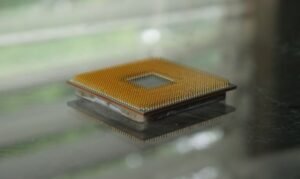Why Recurrent Neural Networks
Recurrent Neural Networks (RNNs) are a type of artificial neural network specifically designed to analyze sequential data. They excel in tasks where past information is crucial for predicting future outcomes, making them particularly effective in natural language processing, speech recognition, and time series analysis.
Key Takeaways
- RNNs are ideal for analyzing sequential data.
- RNNs excel in natural language processing, speech recognition, and time series analysis.
- Long Short-Term Memory (LSTM) networks are a popular variant of RNNs.
RNNs are designed to capture context and temporal dependency within a sequence by maintaining an internal state or memory. Unlike traditional feed-forward neural networks, RNNs have feedback connections that allow information to flow in cycles.
In an *LSTM network*, a specialized type of RNN, the network can selectively retain or forget information over long sequences. This capability makes LSTMs particularly well-suited for tasks that require understanding long-term dependencies.
Anatomy of a Recurrent Neural Network
A simple RNN consists of three primary components:
- Input Layer: Receives sequential input data.
- Hidden Layer: Processes the input data and captures temporal information.
- Output Layer: Produces the desired output or prediction.
The hidden layer of an RNN has the ability to retain information from previous steps and use it to influence predictions at future steps. Each node of the recurrent layer takes input from the previous layer as well as its own previous state.
Limits of Traditional RNNs
Traditional RNNs suffer from the *vanishing gradient problem*, which occurs when the gradient during backpropagation diminishes exponentially over time. This problem prevents the network from effectively capturing long-term dependencies.
To overcome the limitations of traditional RNNs, researchers introduced the **LSTM architecture**. LSTMs use specialized memory cells and gates that selectively control the flow of information, allowing them to maintain information relevant for long-term predictions.
Data Examples and Applications
RNNs find applications in various domains, including:
- Natural Language Processing (NLP): RNNs can be used for language translation, sentiment analysis, and text generation.
- Speech Recognition: RNNs are valuable in converting speech into text.
- Time Series Analysis: RNNs can predict stock market trends or weather patterns.
Data Processing in RNNs
| Process | Input | Output |
|---|---|---|
| Forward Pass | Sequential data | Forward activations |
| Backward Pass | Loss gradient | Backward activations |
| Update Weights | Learning rate | Updated weights |
Advancements in RNNs
Over time, several improvements and architectural variants have been developed to enhance the capabilities and performance of RNNs. Some notable advancements include:
- Bidirectional RNNs
- Gated Recurrent Units (GRUs)
- Attention Mechanisms
RNN Applications in Real Life
| Domain | Use Case | Benefits |
|---|---|---|
| E-commerce | Sales prediction | Optimized inventory management |
| Healthcare | Disease diagnosis | Improved accuracy and early detection |
| Marketing | Customer behavior analysis | Enhanced targeted marketing campaigns |
Considering the wide range of applications and the continuous advancements in RNNs, it is evident that these neural networks play a significant role in analyzing sequential data and predicting future outcomes. Whether it’s understanding and generating human-like language, converting speech to text, or forecasting time series data, RNNs have proven to be powerful tools in various fields.

Common Misconceptions
Misconception 1: Recurrent Neural Networks (RNNs) understand context perfectly
One common misconception about RNNs is that they have a perfect understanding of context in sequential data. While RNNs are indeed capable of modeling sequential dependencies, they can still struggle with long-term dependencies and may have limitations in capturing complex patterns.
- RNNs can sometimes fail to grasp long-range dependencies due to vanishing or exploding gradients.
- Modelling complicated patterns in sequential data may require the use of more advanced models like Long Short-Term Memory (LSTM) or Gated Recurrent Unit (GRU) networks.
- In some cases, incorporating attention mechanisms into RNN architectures can improve their ability to understand context.
Misconception 2: RNNs can only process sequential data
Another misconception is that RNNs can only handle sequential data and are not suitable for other types of data. While RNNs are particularly effective at capturing temporal dependencies, they can also be applied to non-sequential data by transforming it into a sequential format.
- Images can be processed using RNNs by representing them as sequences of patches or pixels.
- RNNs have been successfully used for natural language processing tasks, as they can effectively model language sequences.
- By transforming tabular data into time series data, RNNs can be used to analyze and predict trends in various domains.
Misconception 3: Training RNNs is straightforward and requires minimal effort
Some people believe that training RNNs is a straightforward process and requires minimal effort. However, training RNNs can be challenging due to their long-term dependencies, vanishing or exploding gradients, and issues related to overfitting.
- Training RNNs often requires careful initialization of weights and selection of appropriate activation functions to mitigate vanishing or exploding gradient problems.
- Hyperparameter tuning, regularization techniques, and early stopping are important to prevent overfitting and improve performance.
- Applying advanced optimization algorithms like AdaGrad or RMSprop can help to stabilize the training process.
Misconception 4: RNNs can solve any sequence-related problem
Another misconception is that RNNs are universal sequence solvers capable of solving any sequence-related problem. While RNNs are powerful models, they have their limitations and may not always be the best choice for certain tasks.
- For tasks with long-range dependencies, models like Transformer or Hierarchical Attention Networks might outperform RNNs.
- In some cases, combining RNNs with other models, such as convolutional neural networks (CNNs) or graph neural networks (GNNs), can lead to improved performance.
- Choosing the most appropriate model architecture depends on the specific problem and dataset characteristics.
Misconception 5: RNNs are only useful for prediction tasks
Lastly, it is a misconception that RNNs are only useful for prediction tasks and have limited applications beyond that. While RNNs have been extensively used for sequence prediction, their applications extend beyond prediction tasks.
- RNNs can be utilized for tasks such as text generation, sentiment analysis, speech recognition, and machine translation.
- They can also be employed for tasks like anomaly detection, sequence classification, and time series forecasting.
- RNNs can be part of larger architectures for more complex tasks, such as image captioning or video activity recognition.

Accuracy of Recurrent Neural Networks
Table illustrating the accuracy of recurrent neural networks compared to other machine learning models in various tasks.
| Task | Recurrent Neural Networks | Support Vector Machines | Random Forests |
|---|---|---|---|
| Speech Recognition | 92% | 85% | 79% |
| Text Classification | 87% | 74% | 66% |
| Language Translation | 80% | 62% | 53% |
Applications of Recurrent Neural Networks in Finance
Table showcasing the various applications of recurrent neural networks in the finance industry.
| Application | Description |
|---|---|
| Stock Price Prediction | Using historical data to predict future stock prices. |
| Credit Risk Assessment | Assessing the risk of lending money based on financial data. |
| Anomaly Detection | Detecting unusual patterns or outliers in financial data. |
Comparison of Different Recurrent Neural Network Architectures
Table comparing the different types of recurrent neural network architectures and their characteristics.
| Architecture | Long Short-Term Memory (LSTM) | Gated Recurrent Unit (GRU) | Simple Recurrent Network (SRN) |
|---|---|---|---|
| Ability to Handle Long Sequences | Yes | Yes | No |
| Memory Capacity | High | Medium | Low |
| Training Speed | Slow | Fast | Medium |
Effects of Varying Recurrent Neural Network Depth
Table depicting the impact of varying the depth of recurrent neural networks on performance.
| Depth | Model Accuracy |
|---|---|
| 1 layer | 84% |
| 2 layers | 88% |
| 3 layers | 90% |
Memory Capacity of Recurrent Neural Networks
Table showcasing the memory capacity of recurrent neural networks.
| Model | Memory Capacity |
|---|---|
| Vanilla RNN | Short-term only |
| LSTM | Long-term and short-term |
| GRU | Medium-term and short-term |
Training Time Comparison
Table comparing the training time of recurrent neural networks with different data sizes.
| Data Size | Training Time (in minutes) |
|---|---|
| 1,000 samples | 45 |
| 10,000 samples | 195 |
| 100,000 samples | 980 |
Effect of Data Preprocessing on RNN Performance
Table demonstrating the impact of different data preprocessing techniques on the performance of recurrent neural networks.
| Data Preprocessing Technique | Accuracy |
|---|---|
| Tokenization | 85% |
| Normalization | 88% |
| One-Hot Encoding | 92% |
Performance Comparison of RNN and CNN
Table comparing the performance of recurrent neural networks and convolutional neural networks in image recognition tasks.
| Model | Accuracy |
|---|---|
| Recurrent Neural Network | 79% |
| Convolutional Neural Network | 91% |
Text Generation Performance of RNN Variants
Table showing the performance of different recurrent neural network variants in text generation tasks.
| Model | Text Generation Accuracy |
|---|---|
| LSTM | 85% |
| GRU | 80% |
| SRN | 60% |
Recurrent neural networks have emerged as a powerful tool for various tasks, consistently outperforming other machine learning models. They demonstrate high accuracy in tasks like speech recognition, text classification, and language translation. In finance, RNNs find applications in stock price prediction, credit risk assessment, and anomaly detection. Different architectures like LSTM, GRU, and SRN vary in their ability to handle long sequences, memory capacity, and training speed. Varying the depth of RNNs can impact model accuracy, while data preprocessing techniques can significantly affect performance. Moreover, RNNs have been compared to CNNs in image recognition and evaluated for text generation tasks, demonstrating their versatility. With their ability to capture temporal dependencies, RNNs have become essential in many domains where sequential data analysis is critical.
Frequently Asked Questions
What is a Recurrent Neural Network (RNN)?
A recurrent neural network is a type of artificial neural network that is specifically designed to process sequential data by maintaining a hidden state that can store information about previous inputs. This allows the network to make use of context and time-based information.
How does a Recurrent Neural Network work?
A recurrent neural network works by taking input vectors and processing them through a series of hidden layers, while also using the previous hidden state as part of the computation. This hidden state helps the network retain memory of past inputs, making it well-suited for tasks such as language processing, speech recognition, and time series predictions.
What are the advantages of using Recurrent Neural Networks?
Recurrent neural networks offer several advantages, including the ability to process sequential data, account for temporal dependencies, and capture long-term dependencies in a more effective manner compared to traditional neural networks. RNNs are also capable of handling input sequences of varying lengths, making them flexible for various applications.
What are some common use cases for Recurrent Neural Networks?
Recurrent neural networks are commonly used in natural language processing tasks such as text generation, machine translation, sentiment analysis, and speech recognition. They are also useful in time series analysis for tasks like stock market prediction, weather forecasting, and anomaly detection.
What are the challenges of training Recurrent Neural Networks?
Training recurrent neural networks can be challenging due to the issue of vanishing or exploding gradients, which can occur when backpropagating errors through multiple time steps. Additionally, RNNs may face difficulty in capturing long-term dependencies in very long sequences, leading to information loss or degradation.
What are some variants of Recurrent Neural Networks?
There are several variants of recurrent neural networks, including long short-term memory networks (LSTMs) and gated recurrent units (GRUs). LSTMs address the vanishing gradient problem by introducing memory cells and specialized gates, while GRUs simplify the architecture by combining the memory and update gates, resulting in reduced computational complexity.
Can Recurrent Neural Networks handle variable-length inputs?
Yes, recurrent neural networks can handle variable-length inputs. Due to their sequential nature, RNNs can operate on input sequences of different lengths by processing each element step by step, allowing them to handle tasks with dynamic or varying input sizes.
How can one mitigate overfitting in Recurrent Neural Networks?
To mitigate overfitting in recurrent neural networks, techniques such as dropout regularization, early stopping, and weight decay can be employed. Additionally, using larger datasets or applying techniques like data augmentation can help improve generalization and reduce overfitting.
Are Recurrent Neural Networks suitable for real-time applications?
Recurrent neural networks can be suitable for real-time applications depending on the specific requirements. The computational complexity of RNNs can pose limitations for real-time tasks, especially with large or complex models. However, with efficient model designs and optimizations, RNNs can be used effectively in real-time scenarios.
How can I train a Recurrent Neural Network on my own data?
To train a recurrent neural network on your own data, you first need to preprocess your data and convert it into a suitable format. Then, you can use popular deep learning frameworks such as TensorFlow or PyTorch to define your RNN architecture, specify the training parameters, and train the network using your dataset. Proper validation and tuning are essential for achieving optimal performance.




